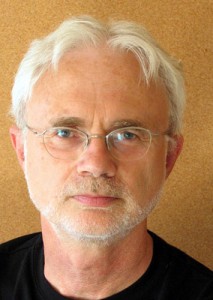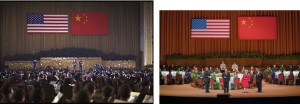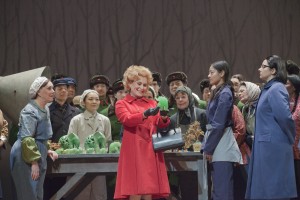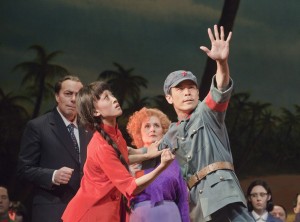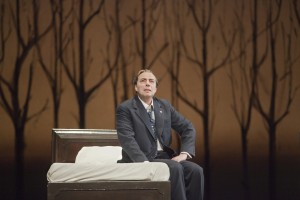You may not necessarily enjoy Nixon in China by John Adams but you may be in danger of being ensnared or seduced by it.
An eleven-year old boy once confided to me, “I don’t like spinach. I’m glad I don’t like spinach, because if I liked it, I’d eat it, and I hate the d–d stuff.”
Be warned. If you are convinced that no composer since Puccini (or Mozart or Monteverdi) has or ever will write an opera worth attending, stay away from John Adams’ Nixon in China. If you believe that “Tricky Dick” was a total scumbag as a president and as an individual, don’t come to the Encore on Wednesday, March 2. I’m not saying you’ll necessarily enjoy the opera, but you are in danger of being ensnared or seduced by it.
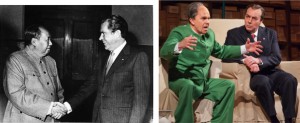
Chairman Mao meets President Nixon (L: News photo from the web; R: Robert Brubaker & James Maddalena)
Kudos to the ҬCostume Designer, Dunya Ramicova and to the back-stage people responsible for Wigs and Makeup. The three principal Americans were immediately recognizable to those of us old enough to have been reading papers and watching TV 40 years ago. The identities of Richard Nixon, Pat Nixon, and Henry Kissinger were obvious the instant each appeared on stage.
I try, but I can’t honestly say that I like very much of John Adams’ music. I would never willingly listen to a solely audio performance of Nixon in China or any of his other operas. BUT, and it’s a big BUT, his music is absolutely perfect for this gripping drama of the last week in February 1972.
The overture starts with an eight-chord theme which is repeated over and over and over in a low register while all sorts of orchestral harmonies and disharmonies and wild vocal gymnastics go on above it. It repeats and repeats and repeats. The particular 8 chords will change from time to time; the volume may become more or less; the key may be different – but the endless pounding beat is always there. The tension grows and grows and grows. As well it should. For this opera is a story of a meeting between two of the most powerful men in the world – men who have never been face to face before – men who stand for polar opposites in politics and economics.
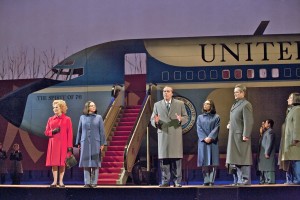
Janis Kelly, far left, as Pat Nixon, Teresa S. Herold as second secretary to Mao, James Maddalena as Richard Nixon, Ginger Costa Jackson as first secretary to Mao, and Russell Braun as Chou En-Lai
Debarking from a plane is American President Richard Nixon, a man who built his whole career on an intense and emotional stance against Communism in all its manifestations. Waiting there to meet him is Chinese Premier Chou En-Lai, a man who built his whole career on an intense and emotional stance against foreign Imperialism in all its manifestations. To the United States, the People’s Republic of China was the quintessence of Communism; to the PRC, the US was the quintessence of Imperialism. Imagine the tension present in all persons involved in that meeting!
A good opera based on history is like a good historical novel. The basic history must conform to what really happened, but dramatic license allows for changing or creating minor differences with history. For a brief historical account, see the Wikipedia article on Nixon’s visit to China.
For example, in 1972, Henry Kissinger visited China before Nixon in order to arrange details of the President’s visit – in the opera he is part of the Presidential party.
The opera is divided into three acts representing the first day, a day in the middle, and the final day of the week-long visit. In the first act the scenes shift from the welcome at the airport to the meeting with Mao Tse-Tung at his house to the formal banquet in the evening. The drama here is all in the words (and, of course, the music); action and scenery are relatively unimportant. I have the impression that the Americans are being very careful in what they say. It is more important that they do not say anything wrong than that they do say anything important. The same is true of Chou – perhaps even more so – but Mao appears to be more relaxed; he wants to talk about philosophy.
The first few scenes of Act II show Pat Nixon visiting various places and institutions, including the Peking Glass Factory where the workers present her with a green glass elephant, and an elementary school. In the evening the Nixons attend a performance of the well-know ballet written by Madam Mao Chiang Ch’ing called The Red Detachment of Women.
Choreographer Mark MorrisӬ has created a vivid short version of the ballet which apparently is very true to the original. Early in the ballet the peasant girl Wu Qinghua is whipped by the evil landlord Nanbatian until she falls unconscious. The ballet is so realistic that Pat Nixon thinks it is real and rushes on stage to save the girl, followed by her husband who tries to explain to her that Wu is just an actor in a play. Instead, the ballet becomes surreal with no clear line between the ballet performers and the audience which eventually includes both Nixons and Madame Mao (Kathleen Kim).
The name Kathleen Kim rang a bell with me but it took me a moment to recollect the association. Last year I saw her on MetHD as Olympia, the dancing doll in Tales of Hoffman. Talk about different roles! Her appearance, singing, and dancing were perfect as the mechanical doll; and here she seemed perfectly cast as the blood-thirsty foul-mouthed woman revolutionary. I hope I shall see more of this young lady.
In another interesting quirk of casting, Nanbatian is played by Richard Paul Fink, the same singer who plays Henry Kissinger. As Kissinger, he is, of course, made up to look as much like the real Henry as possible. As Nanbatian he is made up to look like an actor who is made up to look like a caricature of Kissinger. The effect is wonderful.
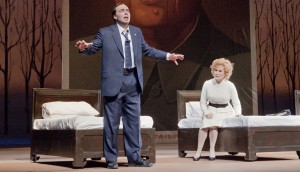 In the final act, the Great Hall has been set up as a dormitory with a single bunk bed for each of the principal characters. However, although they are physically close together, each couple or individual is entirely alone with their thoughts, fears, and aspirations. James Maddalena, who has been playing the role of Nixon all over the world ever since the premiere in Houston in 1987, portrays him as a deeply troubled person who has nightmares wondering if he has done the right thing for his country. Janis Kelly portrays Pat Nixon as a loving and caring wife; she is a bit-player on a historical stage with the important role of helping her husband as the lead. Even though I lived through that period of history, I must admit that Saturday was the first time that I ever thought of the Nixons as real human beings.
In the final act, the Great Hall has been set up as a dormitory with a single bunk bed for each of the principal characters. However, although they are physically close together, each couple or individual is entirely alone with their thoughts, fears, and aspirations. James Maddalena, who has been playing the role of Nixon all over the world ever since the premiere in Houston in 1987, portrays him as a deeply troubled person who has nightmares wondering if he has done the right thing for his country. Janis Kelly portrays Pat Nixon as a loving and caring wife; she is a bit-player on a historical stage with the important role of helping her husband as the lead. Even though I lived through that period of history, I must admit that Saturday was the first time that I ever thought of the Nixons as real human beings.The Encore performance will be at 6:30 local time on Wednesday, March 2 – and I’m faced with a difficult choice. Do I see Nixon in China again at the Cinemark theatre in Palo Alto, or do I drive to Camera 7 in Campbell to see an HD performance of La Traviata from the Royal Opera House in London and starring RenÉe Fleming? I’ll let you know.
The Opera Nut
Except as noted, news photos from the 1970’s were taken from the web and other photos are by Ken Howard/Metropolitan Opera.
This review by Philip G Hodge appeared in sanfranciscosplash.com on February 19, 2011.



